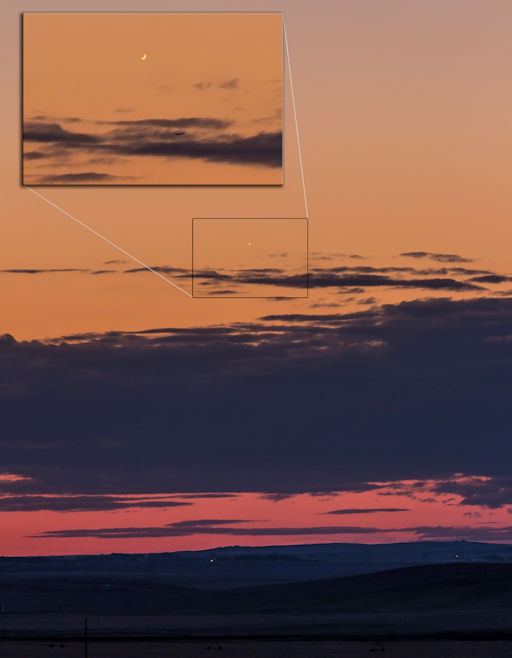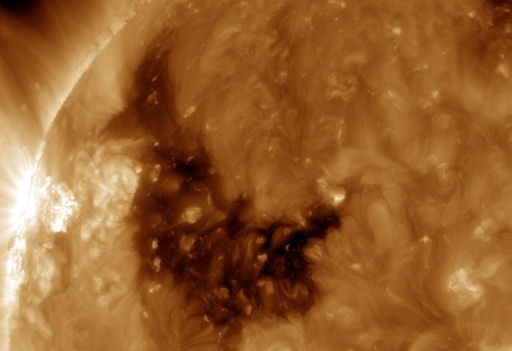ISS TRANSIT OF VENUS: High above Earth, astronaut Don Pettit is about to become the first human to witness and photograph a transit of Venus from space. His images and commentary will be streamed to Earth during the crossing. [full story] [video]
VENUS SIGHTINGS: Venus is approaching the sun for an historic transit on June 5th and 6th. Sky watchers accustomed to seeing the Goddess of Love shining brightly in the evening sky are having to look harder than usual as Venus plunges into the glare:
"It was a wonderful sight tonight, as I caught Venus in its last days before the transit, shining as a glistening crescent low in the evening twilight," says photographer Alan Dyer of Gleichen, Alberta, Canada. "Venus was visible to the unaided eye after sunset, but not for long. It set soon after the Sun. But for a short while it put on a beautiful show as a large crescent (large for a planet that is), easily resolvable in binoculars and stunning in a small telescope. One could almost make out, for brief moments, the sight of the backlit atmosphere going all the way around the disk. But I suspect it was more imagination at work than reality shining through."
"This was May 30, 6 days before the June 5 transit, with Venus 9.5° east of the sun. How far up to the Sun can we catch it, before it crosses the sun on Tuesday?" he wonders. The answer will be revealed in SpaceWeather's realtime photo gallery.
Space Weather Real Time Image Gallery
[Submit your photos] [NASA video: 2012 Transit of Venus]
CORONAL HOLE: Spewing solar wind, a yawning dark fissure in the sun's atmosphere is turning toward Earth. NASA's Solar Dynamics Observatory photographed the "coronal hole" during the early hours of June 1st:
Coronal holes are places where the sun's magnetic field opens up and allows the solar wind to escape. A stream of solar wind flowing from this coronal hole will reach Earth on June 5th - 7th, possibly stirring geomagnetic storms. High-latitude sky watchers should be alert for auroras. Aurora alerts: text, voice.
ISS TRANSIT OF VENUS: High above Earth, astronaut Don Pettit is about to become the first human to witness and photograph a transit of Venus from space. His images and commentary will be streamed to Earth during the crossing. [full story] [video]
VENUS SIGHTINGS: Venus is approaching the sun for an historic transit on June 5th and 6th. Sky watchers accustomed to seeing the Goddess of Love shining brightly in the evening sky are having to look harder than usual as Venus plunges into the glare:
"It was a wonderful sight tonight, as I caught Venus in its last days before the transit, shining as a glistening crescent low in the evening twilight," says photographer Alan Dyer of Gleichen, Alberta, Canada. "Venus was visible to the unaided eye after sunset, but not for long. It set soon after the Sun. But for a short while it put on a beautiful show as a large crescent (large for a planet that is), easily resolvable in binoculars and stunning in a small telescope. One could almost make out, for brief moments, the sight of the backlit atmosphere going all the way around the disk. But I suspect it was more imagination at work than reality shining through."
"This was May 30, 6 days before the June 5 transit, with Venus 9.5° east of the sun. How far up to the Sun can we catch it, before it crosses the sun on Tuesday?" he wonders. The answer will be revealed in SpaceWeather's realtime photo gallery.
Space Weather Real Time Image Gallery
[Submit your photos] [NASA video: 2012 Transit of Venus]
CORONAL HOLE: Spewing solar wind, a yawning dark fissure in the sun's atmosphere is turning toward Earth. NASA's Solar Dynamics Observatory photographed the "coronal hole" during the early hours of June 1st:
Coronal holes are places where the sun's magnetic field opens up and allows the solar wind to escape. A stream of solar wind flowing from this coronal hole will reach Earth on June 5th - 7th, possibly stirring geomagnetic storms. High-latitude sky watchers should be alert for auroras. Aurora alerts: text, voice.

![]()
Solar wind
speed: 363.3 km/sec
density: 14.5 protons/cm3
explanation | more data
Updated: Today at 1516 UT
![]()
X-ray Solar Flares
6-hr max: C1 1047 UT Jun01
24-hr: C2 0534 UT Jun01
explanation | more data
Updated: Today at: 1500 UT
![]()
![]()
![]()
Daily Sun: 01 Jun 12
![]()
![]()
The sunspot number is increasing, setting an active stage for the June 5th Transit of Venus. Credit: SDO/HMI
![]()
![]()
![]()
Sunspot number: 76
What is the sunspot number?
Updated 31 May 2012
Spotless Days
Current Stretch: 0 days
2012 total: 0 days (0%)
2011 total: 2 days (<1%)
2010 total: 51 days (14%)
2009 total: 260 days (71%)
Since 2004: 821 days
Typical Solar Min: 486 days
Updated 31 May 2012
The Radio Sun
10.7 cm flux: 117 sfu
explanation | more data
Updated 31 May 2012
![]()
![]()
![]()
Current Auroral Oval:
![]()
Switch to: Europe, USA, New Zealand, Antarctica
Credit: NOAA/POES
![]()
![]()
![]()
Planetary K-index
Now: Kp= 2 quiet
24-hr max: Kp= 3 quiet
explanation | more data
![]()
Interplanetary Mag. Field
Btotal: 4.2 nT
Bz: 2.4 nT north
explanation | more data
Updated: Today at 1516 UT
![]()
![]()
![]()
Coronal Holes: 01 Jun 12
![]()
![]()
A large coronal hole is emerging over the sun's eastern limb. Solar wind flowing from the opening should reach Earth on June 5-7. Credit: SDO/AIA.






